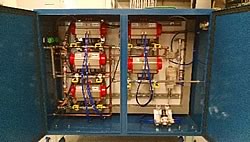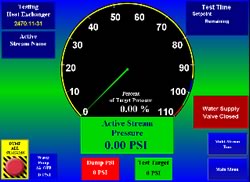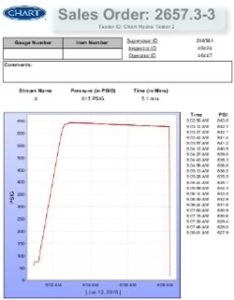Heat Exchanger Hydrostatic Pressure Tester
 Customer: Chart Energy & Chemicals
Customer: Chart Energy & Chemicals
Project Scope: Part of the manufacturing process for Chart’s heat exchangers is to test the core under high hydro static pressure. The old process was manually performed, provided rough test documentation, and had the potential to over pressure the core to the point that it would need to be scrapped. Any over pressurization beyond specification would need to be reported to the customer and, at times, the customer would not accept the core or it would need to be down-graded. Frequently, multiple cores streams would need to be tested at the same time, which is called a Simultaneous test. This would require multiple manual pumps and chart recorders.
 Project Design: Industrial Automation was asked to design, construct, and program a new portable heat exchanger and water pressure tester. The new pressure tester will utilize an Allen Bradley Compact Logix PAC controller to monitor all system pressure sensors and to control all water, air valves, and indicators. A 15-inch industrial touch screen connected to an industrial PC running Ignition from Inductive Automation will serve as the HMI/SCADA system. The Ignition SCADA/HMI system controls, monitors, and records all four core streams along with the high pressure supply side. All high pressure devices and piping are stainless steel and rated at 4,000 PSI or greater.
Project Design: Industrial Automation was asked to design, construct, and program a new portable heat exchanger and water pressure tester. The new pressure tester will utilize an Allen Bradley Compact Logix PAC controller to monitor all system pressure sensors and to control all water, air valves, and indicators. A 15-inch industrial touch screen connected to an industrial PC running Ignition from Inductive Automation will serve as the HMI/SCADA system. The Ignition SCADA/HMI system controls, monitors, and records all four core streams along with the high pressure supply side. All high pressure devices and piping are stainless steel and rated at 4,000 PSI or greater.
 The tester will include valves and pressure sensors to monitor and control the inlet and outlet water pressure to four isolated single stream zones simultaneously. Three qualified people will each be required to enter the core test parameters prior to starting each test via the touch screen. Each person will be assigned a specific key to gain access to the corresponding test setup screen. When all three sets of data match, the appropriate water and air valves will be energized to allow the pressure test to start. In addition to the test setup security, there is also a maintenance setup and calibration page that requires a key and password to enter.
The tester will include valves and pressure sensors to monitor and control the inlet and outlet water pressure to four isolated single stream zones simultaneously. Three qualified people will each be required to enter the core test parameters prior to starting each test via the touch screen. Each person will be assigned a specific key to gain access to the corresponding test setup screen. When all three sets of data match, the appropriate water and air valves will be energized to allow the pressure test to start. In addition to the test setup security, there is also a maintenance setup and calibration page that requires a key and password to enter.
 The tester will first allow filling of the core. When the vessel is completely filled and air pockets removed, the air driven water pump will start to pressurize the core. The pump will be automatically shut off at a predetermined pressure that is less than the maximum desired vessel test pressure. An operator will then use a hand pump to raise the vessel testing pressure to the desired final test pressure. If the vessel pressure becomes greater than the test high limit (Target Test Pressure Value *1.05), the inlet water valve and the air supply valve will close to stop further pressurization. If the vessel pressure rises to a second higher limit set point (Target Test Pressure Value *1.06) or 75 PSI above the test high limit, the test will be aborted and the outlet valve will open to relieve the vessel pressure. Once a core is at the desired test pressure and the supply valve is closed, a timed test is performed. If the core loses too much pressure during a predetermined time, the test is aborted. If the test is passed, then all of the test data is gathered into a printable report. In addition, the data is saved to a historical database for future use.
The tester will first allow filling of the core. When the vessel is completely filled and air pockets removed, the air driven water pump will start to pressurize the core. The pump will be automatically shut off at a predetermined pressure that is less than the maximum desired vessel test pressure. An operator will then use a hand pump to raise the vessel testing pressure to the desired final test pressure. If the vessel pressure becomes greater than the test high limit (Target Test Pressure Value *1.05), the inlet water valve and the air supply valve will close to stop further pressurization. If the vessel pressure rises to a second higher limit set point (Target Test Pressure Value *1.06) or 75 PSI above the test high limit, the test will be aborted and the outlet valve will open to relieve the vessel pressure. Once a core is at the desired test pressure and the supply valve is closed, a timed test is performed. If the core loses too much pressure during a predetermined time, the test is aborted. If the test is passed, then all of the test data is gathered into a printable report. In addition, the data is saved to a historical database for future use.
Project Results: The heat exchanger hydrostatic pressure tester delivers the machine safety, reliability, speed, and test data reporting as promised. The management team is pleased with the installation and the ability to update and change the project on the fly. Knowing that the Ignition system is not dependent on any specific operating systems removes machine dependency concerns.
